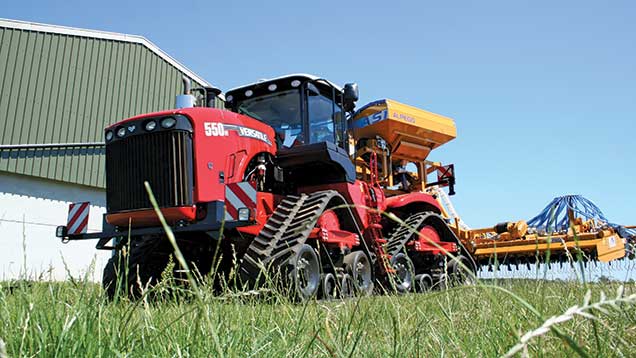Giant 8m Italian combi drill helps in blackgrass battle

A Suffolk estate that’s made a big investment in increased cultivations and drilling firepower as part of a new strategy to combat blackgrass will have a unique claim to fame when its new combi seed drill sows the UK’s first sugar cane crop next spring.
The experiment on 40ha of the lighter land farmed by Nick Levett-Scrivener at Sibton, Suffolk, is part of a variety development programme originating in Barbados.
The crop will not be good enough to crush for sugar, but is expected to yield a decent amount of biomass for a local anaerobic digestion power plant that Sibton Abbey already supplies with whole-cropped hybrid rye.
See also: Cereals 2015: 8 machinery highlights from the show
That crop yields 10-15t/acre (25-37t/ha) of biomass; the cane could produce 30-35t/acre (74-87t/ha) when it is harvested in September.
Of arguably greater significance, however, is the drill’s role in a revamped approach to crop establishment for conventional arable crops across 570ha of mainly heavy land aimed at tackling the blackgrass that threatens grain and oilseed yields.
More ploughing
“Our priorities are to increase the proportion of land ploughed each year, push autumn sowing dates later and increase spring cropping as part of a package of cultural measures to control blackgrass more effectively,” says manager Matt Stanford. “To achieve that with just two of us, we need more capacity so that when the time is right, we can cover a lot of ground.”
In previous years, the farm’s oilseed rape and feed varieties of winter wheat, winter barley and spring barley were sown either under a minimum tillage regime using a 4m trailed Vaderstad Rapid on stubbles broken by a Simba Cultipress, or with a 4m Lemken power harrow-seed drill combination after ploughing.
“We did look at running an 8m Rapid to give us more capacity,” says Mr Stanford. “But where we plough, we have to do so much cultivation here before the Rapid will work that we felt going for a power harrow drill combination and doing it all in one go would be a better solution.”
A larger Lemken combi was ruled out by its performance in marginal conditions. It worked well enough on a relatively dry, friable soil, says Matt Stanford, but lack of separation between the front and rear rows of disc coulters, which are in an interlocking layout, resulted in frequent clogging up when conditions became sticky.
A wholesale upgrade of the arable toolkit has brought in a nine-furrow Dowdeswell 170 Series mounted plough with 10-furrow capability and a 6m disc-tine-disc-packer trailed Sumo Quatro cultivator.
Then there is the 8m Alpego Airspeed AS1-800 combi drill that proved quite an eye-catcher at this year’s Cereals event mounted on the farm’s new Versatile DeltaTrack power unit. This too should lift operator productivity to allow later sowing dates while also coping with adverse soil conditions in a difficult autumn or spring.
“We’ll continue with some min-till but I’m aiming to increase the proportion of land ploughed each year to at least a third or more,” says Mr Stanford. “For sowing oilseed rape, we’ll lift the Quatro’s discs and just use the tines with low disturbance points to minimise surface soil movement, and then put seed and phosphate fertiliser down with Sumo’s new coulters for more precise seed placement.
“The Quatro will also be used to bust oilseed rape stubbles before going in with the combi drill,” he adds, “and other cereal crops will be established by the combi after ploughing, possibly with a bit of working down by the Cultipress if necessary.”
Working width
Going 8m for the combi drill fits the farm’s established 24m set up for tramlines and makes use of the Versatile’s copious power outputs.
“It was the only one we found with a high enough gearbox rating for the tractor,” says Nick Levett-Scrivener. “But that wasn’t the only factor – we liked the look of the single disc coulters, which are arranged in two distinct rows so that there’s lots of space for soil to flow between them.”
Each disc and seed boot assembly is mounted on an individual trailing arm attached to the frame by rubber cushioned clamps. Seed is delivered via distribution heads by air from hydraulically driven fans and an electric-drive metering mechanism located beneath each hopper.
The two 1,400-litre steel hopper assemblies – normally fitted singly in piggy-back style on a 4m combi – are mounted on a bolt-down frame engineered by the Italian manufacturer and its new importer, Warren Rivers-Scott at Alpego UK that incorporates pallet fork slots for lifting the whole lot on and off in one go.
This arrangement makes good use of the space above the four-belt tractor’s rear axle and good weight distribution is reckoned to be maintained by the inevitable front-end bias that comes from sticking a 15-litre Cummins six-pot diesel in the nose, followed by a heavyweight Caterpillar powershift transmission and 1,800-litres of fuel capacity in steel saddle tanks ahead of the central pivot.
The 550DT is the most powerful version of the DeltaTrack built on Versatile’s Winnipeg production line. It sports 550hp at 2,100rpm rated speed before peaking at 1,800rpm with 591hp and 2,780Nm of torque at 1,400rpm.
Its relative simplicity and access for servicing were attractions, along with the larger diameter drive sprocket, big positive-drive lugs on the traction belts and the double axis bogie mounting for the whole assembly.
“Although it’s a big outfit by any standards, the articulated steering and mounted drill should make it more manoeuvrable than operating a large trailed drill in our small fields,” says Mr Levett-Scrivener.
“Our biggest of about 100 fields is only 40ha (100 acres) but, even so, we’re banking on cultivating and drilling up 24ha (60 acres) a day in one-pass, and with the capability of a combi drill to keep working when the autumn rains come and make everything a bit more difficult.”


